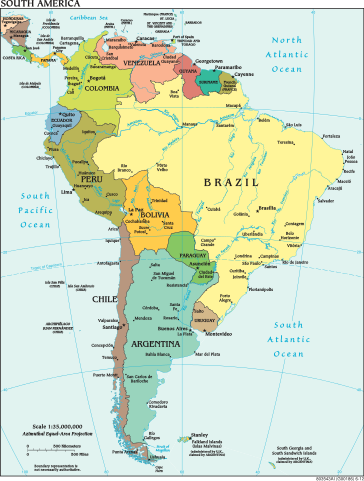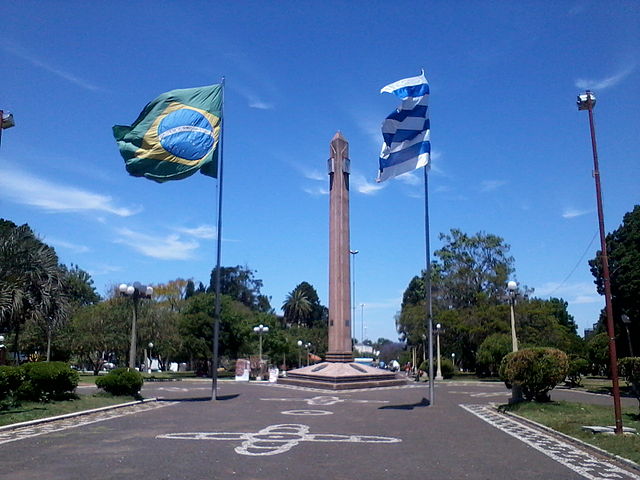The Lovechild of Spanish and Portuguese: Portunhol
Meanwhile, somewhere on the border between Uruguay, Argentina or Paraguay and Brazil:

Photo via Pixabay
Baby Portuñol: Mommy, daddy, where did I come from?
(Spanish and Portuguese look at each other hesitatingly)
Spanish: Ay, how to explain this to the kids?
Portuguese: We both knew this moment was going to come, o meu bem. Let’s just spill the feijão.
Spanish: Mi niña, once upon a time, I saw your mother, Portuguese, walk into a bar and I couldn’t believe my eyes. I think by the way she pronounced her vowels, the exotic, yet familiar vocabulary that she used as she ordered herself a drink, and, not to mention, that flowing intonation, I was electrified.
Portuguese: Certo! I remember that night! You couldn’t keep your olhos off of me!
Spanish: Es verdad. And, well, Portuñol, when two languages get together, they create a new language all together. You were born out of love.
Portuguese: That’s right, querido. You’re not the only one though. Want to find out?
Portuñol: Por favor!
–Commercial break–
Thanks for tuning into that brief clip hoping to better, metaphorically introduce you, the reader, to an incredibly interesting phenomenon: the creation of an unsystematic, dialect that flirts with being considered a pigeon language. In any case, Portuñol or Portunhol, is a spoken and written dialect (for lack of a better word) used along the Spanish-speaking countries bordering with Brazil.
There are believed to be 260,000 speakers who use the language to communicate. Principally, it is a “dialect” based upon code-switching, in which a speaker alternates with ease between one or more languages during mid-conversation. In short it is a linguistic mixture of Gaúcho Portuguese and Rioplatense Spanish.

Photo via Wikipedia
Where It All Began
As both Spanish speakers and Portuguese weren’t able to communicate comprehensively in their mother tongue, it helped to categorise Portuñol as a sort of lingua franca to keep things fresh. Overall, Portuñol is a hybrid language which is also peppered with local indigenous languages. Spanish and Portuguese are both Romance languages with very similar grammatical structures with extremely close lexicons. This in turn helped to make it an easier language to form as the language began to develop by gathering momentum. However, it has also made it harder to pinpoint where they both merge.
Originally along the frontiers between the adjourning countries, the importance of Portuguese was immeasurable for any Spanish speaker due to the scope for commerce. Moreover it was vital for more clandestine affairs, such as cattle smuggling, among other endeavours, around the triple border of Argentina, Brazil and Uruguay, which were extremely commonplace during the 1800s. It’s stated that many lusismos (luso- is the root word for “Portuguese-speaking”), or Portuguese terms, began to embed themselves into common parlance at this stage, with the diaspora of migrants from rural towns into the city in Uruguay after they had come into contact with Portuguese speakers.
Nowadays
The Atlas Lingüístico de Uruguay (The Linguistic Atlas of Uruguay) recounts that there is a 25km stretch of land along northern Uruguay whereby the majority of the population is either bilingual or speaks a variation of Portuñol. Likewise, owing to the border with Brazil, many television stations have shaped and influenced the way in which the language has been preserved by Spanish speakers in its dialectal form, as many continue to consume this form of media. In terms of education, there have always been more opportunities and scope to further one’s self academically across the border in Brazil, hence the necessity to adopt the language, or at least to communicate, in Portuñol.
As with any form of lingua franca, or indeed hybrid language, there are always the detractors. Many scholars and those of the establishment have lambasted the language as a debasing, vulgar and lower class dialect, preferring that both Spanish and Portuguese be taught well and distinctively. Nevertheless, the Uruguayan linguist, Graciela Barrios, famed for her musings on rural Uruguayan Spanish states that, “behind the policies of managing the language, there are discriminatory attitudes. When the government accuses young people of ‘deforming’ the language, it is a sly way of saying – We don’t like young people.” Overall, Barrios is able to perceive how enriching it can be to enhance and further a language which strengthens its own cultural identity in turn.

Photo via Wikipedia
The Debate Goes On
A group of historians, artists and linguists on both sides of the border have stated that it is firmly part of the cultural heritage of both countries. Julio Piastre, a coordinator in Rivera, Uruguay, where one of the Educational and Cultural Ministries is located, states, that before, “for a long time whoever used to speak Portuñol would feel ashamed…As if he/she were suffering an illness, a certain dyslexia. We wish to defend our pride at speaking it.” Of course at this stage in order for it to be deemed part of a world heritage by UNESCO, the Uruguayan government firstly has to deem it to be part of its own cultural heritage, which currently appears to be a stumbling block, as it has not been categorised so.
In conclusion, answering little Portuñol’s question: where did she come from? She came from a wild night out two languages coming together. Now, wait until we tell the story about how Portuñol’s little classmate, Spanglish, grew up into who he is today.
In the meantime, some common words to play with as you mix and match between Spanish and Portuguese:
Atenti: atención; atenção. attention
Camiáu: camión; caminhão.truck
Dispôs: después; depois. After
Ingatado: enamorado, enganchado; apaixonado.enamoured
Liña: frontera, línea divisoria; linha divisoria, fronteira. frontier
Pasaye: pasaje; passagem. Passage or ticket
Ratiño: ratito, momentito; um pouco de tempo. A brief period of time
Séstia: siesta; sesta. Nap
Shinéla: chancleta; chinelo. Sandal
Yeladera: heladera, nevera; refrigerador. Fridge
